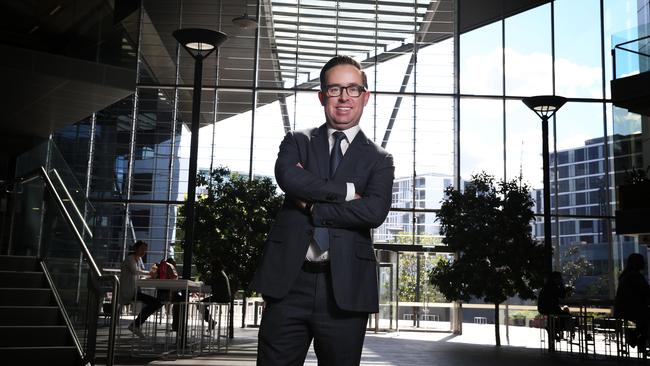Alan Joyce at Qantas bets on tech to drive change
Alan Joyce wants to use technology to drive the next stage of the evolution of the ‘new Qantas’.

It was fitting that Qantas boss Alan Joyce celebrated his 50th birthday on the last day of the last financial year on June 30.
That day his chief financial officer Tino La Spina and his team in the airline’s head office bunker at Mascot had closed the books on the most profitable year in the airline’s 95-year history.
To celebrate his personal milestone Joyce and his partner Shane Lloyd threw a party for family and friends at their harbourside apartment in the Rocks in Sydney.
The next day they flew out for a few weeks’ holiday to Europe. Their first stop was Joyce’s home town of Dublin, where he had a much bigger birthday bash with his parents and friends at the luxury Powerscourt Hotel at Wicklow, south of Dublin.
There were plenty of wellwishers on hand, even from the most unexpected quarters. “We went out pretty late — we let our hair down a bit,” Joyce tells The Weekend Australian.
“The following day at breakfast I got a note from the waiter that had been given to him to pass on by a 737 captain from Brisbane (who was staying at the hotel for a wedding). It read, ‘Great to see you Mr Joyce in Ireland letting your hair down’.”
As he partied the night away Joyce might have reflected on the hockey-stick like recovery since Qantas’s record $2.8 billion loss in 2014. And how he proved the naysayers wrong.
Luck certainly played its part: the airline’s record $1.52bn annual profit for the 12 months to June 30 was helped by lower oil prices and jet fuel costs, which boosted earnings by $664 million. This was also aided by the airline’s world-class hedging strategy.
But the most pleasing aspect for the chief executive was the benefits of cost-cutting — Joyce’s so-called transformation of the airline — that generated $557m worth of benefits in the last financial year. The cost and revenue gains of the program since 2014 are now more than $1.6bn. And there is another $450m to come in the year ahead.
While Qantas has certainly been a beneficiary of the lower oil price, there is no doubt the airline would not be where it is today without its self-help program.
“Fuel has helped, but if was just fuel everyone would be producing record profits. And plenty of our competitors are posting big losses. If there wasn’t the transformation program at Qantas, we simply wouldn’t be producing the profits,” Joyce says.
Investors were rewarded for their patience this week with a full-franked dividend of 7c a share, the first for several years, highlighting the board’s belief that the recovery is now sustainable.
A share buyback program and the return of the dividend means Qantas will have paid back more than $1.5bn to shareholders over the last 18 months.
But Joyce, who celebrated seven years in the job last November, knows he can’t stand still.
International yields are under pressure from capacity growth, the oil price is ticking higher and domestic demand is still weak in the resources sector.
And as he enters the final stretch of his current transformation program, he wants to use technology to drive the next stage of the evolution of the “new Qantas”.
And Joyce has a special interest in the so-called internet of things, given he graduated with honours from the Dublin Institute of Technology with a bachelor of science degree in applied science, majoring in physics and mathematics.
“I always love the Teddy Roosevelt speech where he said you are better off on the arena trying and having some of the successes and failures, than sitting there on the sidelines criticising and not doing anything,” he says of the many technology projects worth hundred of millions that are under way in the airline.
“This is something that we are pretty excited about. A lot of companies talk about it, but we have been using it. And there is so much more in the pipeline.
“I started off as a programmer. At (Irish carrier) Aer Lingus we used punch cards. It is so exciting moving away from manually integrating aircraft to now using these sophisticated tools across the company.”
In June, at its annual innovation day at its Mascot headquarters that was attended by Malcolm Turnbull, Qantas unveiled a 4D flight planning system designed by University of Sydney researchers.
The system combines various aspects of flying, meteorology, traffic flow and fleet operations to design algorithms that will ultimately assist the company to reduce its fuel consumption and improve operational efficiencies.
It will be rolled out across the airline’s operations over the next year.
Qantas is also rolling out a new automated delay recovery system known as Compass, which uses algorithms and data analytics to find solutions, in a matter of seconds, to delays caused by air traffic control flow management or bad weather.
As the airline rolls out free in-flight WiFi on about 100 domestic aircraft under a partnership with global broadband services provider ViaSat, the benefits will flow into the cockpit allowing pilots to stream richer information on real-time weather conditions expected along the flight path.
They can use this to dodge areas of turbulence and make better use of tailwinds to reduce flying time.
WiFi will also be able to reduce the costs of communicating with aircraft given existing satellite and VHF communications cost the company several millions a year across the network.
And for customers, in addition to providing communication services, it could lead to fewer medical diversions which are an all too regular source of delays.
Qantas has recently trialled one device which scans a patient’s heart condition if they are experiencing chest pains.
The heart data is sent by WiFi to a medical officer on the ground, providing a better diagnosis of the passenger to inform the decision whether to divert the plane to another airport or continue to the original destination.
Joyce says the airline is running its IT projects far more efficiently than a decade ago.
“It used to be around 3 per cent of our revenue and it used to be very inefficient. It is now down to 2 per cent and producing far better outcomes,” he says.
Qantas is also using big data and cloud computing to help make better decisions on routes and schedules. In the past, running analysis to try and optimise schedules would take days or weeks.
Cloud computing and big data shrinks this down to a couple of hours.
“This allows us to plan our networks a lot better, which is why we now have a 20 per cent better utilisation of the fleet,” Joyce says.
A new Qantas project known as Red Planet, a media and marketing services business that leverages the airline’s understanding of consumer behaviour and melds it with data analytics, is now using the profiles of the airline’s 11 million frequent flyers to make operational decisions.
“We, for the first time, have a huge amount of insights into our customers and planning,” Joyce says. “Look at the number of routes Qantas and Jetstar operate together on — for example, Qantas has gone back into Maroochydore and the Gold Coast.
“We now have full segmentation of our market that we have done through Red Planet.
“This is allowing us to maximise the returns from the two brands strategy.”
When Jetstar first launched it was rare to see it operating on the same route as Qantas. Now both carriers are on up to 50 routes.
Red Planet is one of the products of the 40-strong team of actuaries and mathematicians who have been working with Qantas since it took a controlling stake in analytics and actuarial consulting business Taylor Fry 18 months ago.
The technology transformation will also extend to aircraft with the arrival over the next year of new Boeing 787 aircraft with better fuel efficiency and longer range, delivering a 30 per cent saving in productivity.
And the A320 Neo aircraft offers a 14 per cent fuel benefit over the present A320 fleet.
Some might dismiss Joyce’s tech push as a gimmick, which could become a distraction from running the everyday business. But Joyce sees it as core to the airline’s future.
“If you look at our transformation program, a large core of it has been technology enabled. These systems are generating hundreds of millions of dollars of benefits for us so without them we would not have got to $1.6bn in savings,” he says.
“We spend over $3bn a year on fuel — if you save 1 per cent out of your fuel bill, that’s hundreds of millions of dollars in benefits.”







To join the conversation, please log in. Don't have an account? Register
Join the conversation, you are commenting as Logout